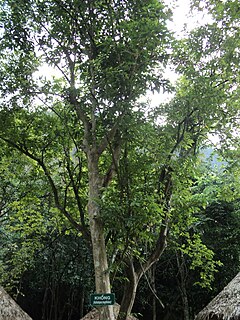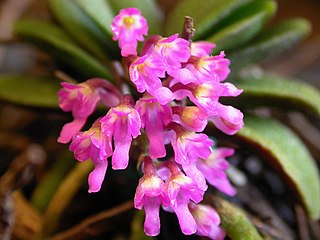
Antidesma is a genus of tropical plant in the family Phyllanthaceae formally described by Linnaeus in 1753. It is native to tropical Africa, S + E + SE Asia, Australia, and various oceanic islands. The greatest diversity occurs in Southeast Asia.

Mallotus is a genus of the spurge family Euphorbiaceae first described as a genus in 1790. Two species are found in tropical Africa and Madagascar. All the other species are found in East Asia, the Indian Subcontinent, Southeast Asia, eastern Australia, and certain islands of the western Pacific.
Trigonostemon is a plant genus of the family Euphorbiaceae and the sole member of its tribe (Trigonostemoneae). It was first described as a genus in 1826. It is native to Southeast Asia, southern China, the Indian Subcontinent, Queensland, and a few islands in the western Pacific.
Paracroton is a genus of flowering plants in the Euphorbiaceae first described as a genus in 1859. It is native to South and Southeast Asia, as well as New Guinea.
- Paracroton integrifolius(Airy Shaw) N.P.Balakr. & Chakr. - Kerala, Tamil Nadu
- Paracroton pendulus(Hassk.) Miq. - India, Sri Lanka, Myanmar, Thailand, Malaysia, Borneo, Sumatra, Philippines
- Paracroton sterrhopodus(Airy Shaw) Radcl.-Sm. & Govaerts - W New Guinea
- Paracroton zeylanicus(Müll.Arg.) N.P.Balakr. & Chakr. - Sri Lanka
Wetria is a plant genus of the family Euphorbiaceae, first described as a genus in 1858. It is native to Australia, New Guinea and Southeast Asia.
- Wetria australiensisP.I.Forst. - Papua New Guinea, Queensland
- Wetria insignis(Steud.) Airy Shaw - Thailand, Myanmar, Peninsular Malaysia, Borneo, Sumatra, Java, Lesser Sunda Islands, Philippines
Spathiostemon is a genus of trees in the Euphorbiaceae family. It is native to the Bismarck Archipelago, New Guinea, Wallacea and Southeast Asia. The trees grow between 10 and 20m tall, often in secondary forest. The wood is sometimes used.
Chondrostylis is a plant genus of the family Euphorbiaceae first described as a genus in 1897. It is native to Thailand, Peninsular Malaysia, Sumatra and Borneo.
- Chondrostylis bancanaBoerl. - Bangka, Kalimantan Tengah
- Chondrostylis kunstleri(King ex Hook.f.) Airy Shaw - S Thailand, W Malaysia, Borneo, Sumatra

Koilodepas is a genus of plant of the family Euphorbiaceae first described as a genus in 1856. It is native to Southeast Asia, India, Hainan, and New Guinea.
Cephalomappa is a genus of plant of the family Euphorbiaceae first described as a genus in 1874. It is native to Malaysia, Borneo, and Sumatra.
- Cephalomappa beccarianaBaill. - Sarawak
- Cephalomappa lepidotulaAiry Shaw - Malaysia, Borneo, Sumatra
- Cephalomappa malloticarpaJ.J.Sm. - Malaysia, Borneo, Sumatra
- Cephalomappa paludicolaAiry Shaw - Sarawak
- Cephalomappa penangensisRidl. - Peninsular Malaysia
Botryophora is a genus of plant of the family Euphorbiaceae first described as a genus in 1888. It contains only one known species, Botryophora geniculata, native to Thailand, Myanmar, Malaysia, Borneo, Sumatra, and Java.
Ptychopyxis is a genus of plant of the family Euphorbiaceae first described in 1861. It is native to Southeast Asia and New Guinea.
- Ptychopyxis arborea - Borneo
- Ptychopyxis bacciformis - Vietnam, Borneo, Sumatra, Philippines, W Malaysia
- Ptychopyxis caput-medusae - W Malaysia
- Ptychopyxis chrysantha - New Guinea
- Ptychopyxis costata - Borneo, Sumatra, W Malaysia
- Ptychopyxis glochidiifolia - Sumatra, Sarawak, Brunei, Kalimantan Timur
- Ptychopyxis grandis - Borneo
- Ptychopyxis javanica - S Thailand, Vietnam, W Malaysia, Borneo, Sumatra, Java
- Ptychopyxis kingii - W Malaysia, E Sumatra, Sarawak, Sabah
- Ptychopyxis plagiocarpa - S Thailand, S Myanmar

Endospermum is a genus of plants, under the family Euphorbiaceae and the monotypic subtribe Endosperminae first described as a genus in 1861 It is native to E + S + SE Asia, Papuasia, Queensland, and certain islands of the W Pacific.

Austrobuxus is a genus of plants under the family Picrodendraceae first described as a genus in 1861. It is native to Southeast Asia, Papuasia, and Australia. The region with the highest diversity is New Caledonia.

Dimorphocalyx is a genus of plants under the family Euphorbiaceae first described as a genus in 1861. It is native to Southeast Asia, Hainan, India, Sri Lanka, New Guinea, and Queensland.

Aporosa is a genus of flowering plant belonging to the family Phyllanthaceae first described as a genus in 1825. It is native to China, the Indian Subcontinent, Southeast Asia, Papuasia, and Queensland.

Breynia is a plant genus in the family Phyllanthaceae, first described in 1776. It is native to Southeast Asia, China, the Indian Subcontinent, Papuasia, Australia, and the island of Réunion.

Tainia, commonly known as ribbon orchids or 带唇兰属 is a genus of about thirty species of evergreen, terrestrial orchids in the distributed from India, China, Japan, Southeast Asia to New Guinea, the Solomon Islands and Queensland.

Barringtonia is a genus of flowering plants in the family Lecythidaceae first described as a genus with this name in 1775. It is native to Africa, southern Asia, Australia, and various islands of the Pacific and Indian Oceans. The genus name commemorates Daines Barrington.

Schoenorchis, commonly known as flea orchids, or 匙唇兰属 , is a genus of flowering plants from the orchid family, Orchidaceae. Plants in this genus are small epiphytes with thin roots, thin leafy stems with leaves in two ranks and tiny fragrant, almost tube-shaped flowers with a prominently spurred labellum. There are about twenty five species found from tropical and subtropical Asia to the Western Pacific.
Pimelodendron amboinicum is a tree species in the Euphorbiaceae family. It is found from the Solomon Islands in the southwest Pacific, west to Sulawesi in Indonesia. The timber is used locally, though larger-scale illegal logging is apparent.










